![]()
![]()
![]()
Use LEFT and RIGHT arrow keys to navigate between flashcards;
Use UP and DOWN arrow keys to flip the card;
H to show hint;
A reads text to speech;
21 Cards in this Set
- Front
- Back
|
Technique of Spontaneity
|
1. Use of unblended, pure colors ("tube colors")
2. Use of visible brushwork 3. Creations of seemingly uncomposed compositions |
|
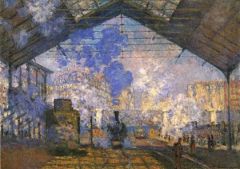
|
St. Lazare Train Station by Claude Monet - 1877 - Impressionism - location favored by Monet b/c smoke & lighting allow for different setting every time
|
|

|
Rouen Cathedral by Claude Monet - 1894 - Impressionism - techniques of spontaneity; series paintings of Cathedral at different points of time; gothic
|
|
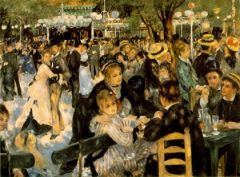
|
Le Moulin de la Galette by Pierre-Auguste Renoir - 1876 - Impressionism - dance parlor where different factions of Parisian society mingle; brushwork of feather-like quality
|
|
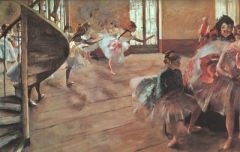
|
Ballet Rehearsal by Edgar Degas - 1874 - Impressionism - techniques of spontaneity: seemingly uncomposed composition, colored shadows, visible brushstrokes (ballet skirts), immediacy (not posed)
|
|
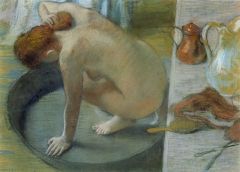
|
The Tub by Edgar Degas - 1886 - Impressionism - Pastel (pure color); woman not on display (private moment, about to take bath, view from back); viewer participant in painting (transgressor or maid?)
|
|
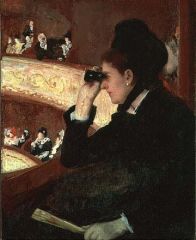
|
The Loge by Mary Cassatt - 1878 - Impressionism - idea of looking while being a spectator
|
|
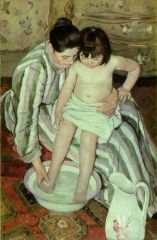
|
The Bath by Mary Cassatt - 1891 - Impressionism - less impressionistic, marking movement of post-impressionism (more defined, lines); viewer part of action of painting
|
|
|
Post Impressionism
|
Term describes artist associated with impressionist movement who transform impressionist goals while retaining impressionist means (color, working before object, vivid). Artists seek to create an art more universal than Impressionism through: Science, believed to have universal validity (geometry, color theory); Artistic tradition (emulation of the past); Human psyche (emotion; spirituality)
|
|
|
Neo-Impressionism
|
used by critics in 1880s to describe Georges Seurat; acknowledges that Seurat's art grows out of impressionism (he exhibited with the impressionists in the early 1880s), but also suggests that Seurat introduces new ideas (e.g., a more scientifically-based color theory).
|
|
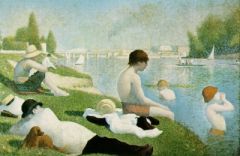
|
Bathers at Asnieres by Georges Seurat - 1883-84 - Post-Impressionism (Neo-impressionism) - Brushstrokes small & unit-ized; poses are strict profiles (planning, regularity, geometric)
|
|
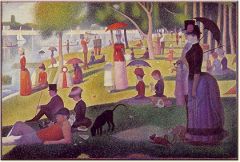
|
Le Grande Jatte by Georges Seurat - 1884-86 - Post-impressionism (neo-impressionism) - pointillism; divisionism
|
|
|
pointillism
|
applying spots of color; implemented by Georges Seurat
|
|
|
divisionism
|
principle that colors vary in appearance depending on what colors are next to them
|
|
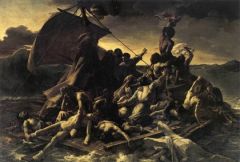
|
Raft of Medusa by Theodore Gericault - 1818-19 - French Romanticism - Gericault's masterpiece; sketching of corpse limbs; cannibalism; romanticism: melancholic, dark side of human nature; depiction of modern event vs. classical history; depiction of missed salvation (ship too far away, false hope)
|
|
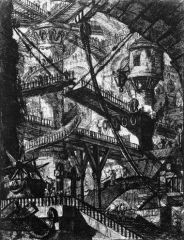
|
Carceri (Prisons) no. 4 by G.B. Piranesi - 1760 - Romanticism (outside France)
|
|

|
Death of Sardanapalus by Eugene Delacrois - 1826 - French Romanticism - Salon exhibition rivalry w/ Apotheosis of Homer; room filled with stuff/carnage; Sardanapalus presented as a genius
|
|
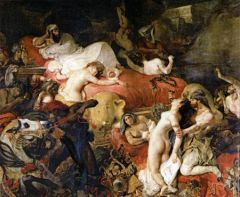
|
Death of Sardanapalus by Eugene Delacrois - 1826 - French Romanticism - salon exhibition rival with Apotheosis of Homer; room filled with stuff/carnage; no depiction of real space; S. presented as genius
|
|
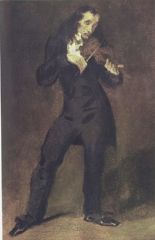
|
Portrait of Paganini by Eugene Delacroix - 1832 - French Romanticism - lost in speed of playing, lost in Paganini's genius; sense that painted with genius (double-genius)
|
|
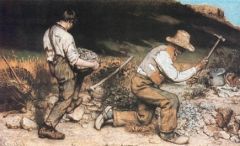
|
The Stone Breakers by Gustave Courbet - 1848 - Realism - same time publish of Marx's Communist Manifesto
|
|
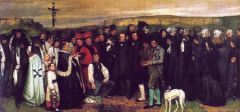
|
Burial at Ornans by Gustave Courbet - 1849 - Realism - The DEAD is not shown. He is not the subject of the painting because HE IS GONE (realism!). The subject is the community that is left behind; Supernatural not depicted, BUT realism perspective: Christ on the Cross (as God existed in concrete, flesh form) on the top of the religious figure’s staff
|

